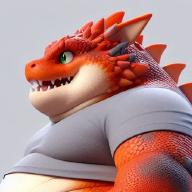World #
A world called Ludra, formerly a playground for a highly advanced race of genetic engineers interested in terraforming, became a swampy, inhospitable place full of strange plant life and island-sized behemoths. Surprisingly, the large creatures maintain a fairly high level of intelligence despite their fairly simple lives of eating and slogging through the swamps in search of food. Only recently has modern technology been reintroduced to them, in a form amenable to their unique bodies.
Subspecies and Physiology #
And yes, there are dragons. There are variants for just about every anthropomorphic species, in reality. However, they have some unique physiology. All of these creatures are ferals, most having six legs, and heavier specimens often have more. Organ systems are redundant, to the point that they are essentially a collection of separate organisms all within one, working in harmony controlled by one mind. They’re notoriously robust, despite an outward appearance that would seem unhealthy to the extreme.
Most individuals don’t even know their own species, as it’s rather difficult to get a good look at one’s own body at that size. The creatures have no known secondary sex characteristics, and likewise with their species, rarely know their own biological sex.
Surveys of the planet were relatively inconclusive. Visually, they are very hard to distinguish in the mucky swamps. Many are in fact mixes of various species, as their original engineering effectively converted them into one unified biological species with individual flair based on traits, much like dog breeds.
The dragons remain one of the more distinctive breeds, though patches of fur isn’t uncommon, or lack of wings, as well. So it can be pretty darn hard to tell what one is.
Due to their extremely redundant bodies, muckbeast lifespans can stretch from hundreds to well over a thousand years. Mating is often performed in the most lackadaisical manner. All muckbeasts, even those of a mammalian subtype, hatch from eggs about 50 feet in diameter. Clutches are typically small, about 2-3 eggs at once.
Culture #
Muckbeasts love to swim and play in the swamps. Most games are simple, with no special equipment required at all, as their low dexterity makes handling objects difficult. Their behavior in this regard can seem somewhat childish, a result of generations of having no obligations nor productive means to pass the time. After modern technology was reintroduced to them, many took a lot of interest in video games, and began communicating with races from other worlds.
Music languished. The muckbeasts were originally from a culture that has a rich musical tradition, but even the simplest instruments were beyond their ability to craft or to play. A few groups kept a crude musical tradition alive, with drums and vocalizations, but their slow speech and voice was not particularly suited to such. This form of art began to be picked up in earnest with the availability of synthesizers, laser string instruments, and brain computer interfaces.
Muckbeasts are inquisitive, curious, and almost universally friendly. They enjoy exploration and meeting new people. The abundant resources of their planet makes conflict rare and such conflicts are usually easily resolved.
They are in general somewhat sexually modest and not excessively driven by physical lusts. They also tend to be comfortable with their body, not seeing themselves as disgusting or unattractive. Obviously, individually there is variance, there are those with self-esteem issues and ones who have superiority complexes. They have their own likes and dislikes, and each have their own personality.
Creators #
Not a whole lot is known about their creators, in actuality, other than they were a bipedal, plain people, who excelled in science. Some even suggest a genetic lineage from them, old tales that their ancestors were transformed, and promised great rewards. Rewards that, if the stories were true at all, never came to fruition. The best guess historians have is that the company spearheading the project eventually dissolved due to lack of funding.
Environment #
The environment is mostly swamplands, with some amount of clear ocean. The climate is mild most of the year, with no harsh winter or summer, such that plant life flourishes all year. Dry land comes at a premium. In fact, the much smaller native wildlife frequently takes up residence on the muckbeasts’ large bodies. All of the muckbeasts are herbivorous, including dragons and felines. It would have of course been totally impractical to require them to eat meat at those gargantuan sizes. Or maybe it was just utopian ideals of the original creators. How would they even catch their prey, anyway?
Muckbeast Design Notes #
Here are a few tips for designing a muckbeast character. Please note they’re only general guidelines, not definitive rules.
- Muckbeast is a variant that can be applied to pretty much any species.
- They have at least three pairs of thick, stocky legs.
- Their fat bellies, as well as their entire underside, drag the ground.
- They have large tails, very wide at the base, and always drag them.
- Their names are usually short and simple.
- Ex. Kib, Rel, Mav, etc.
- A combination of armored plates, scales, fur, and hide are common, regardless of original species.
- Their hides are typically about 3 feet thick, with a layer of protective blubber underneath.
- They don’t eat meat, but junk food is fair game.

